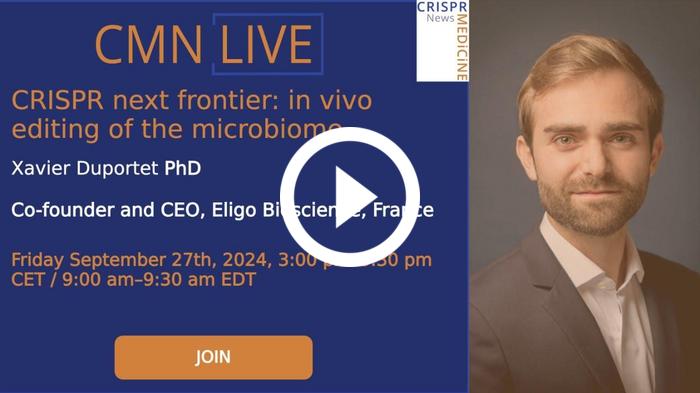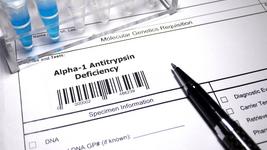CRISPR Next Frontier: In Vivo Editing of the Microbiome. Interview With Xavier Duportet, Eligo Bioscience

(Interview is condensed and edited for clarity)
Karen – Xavier, thanks for joining us in the CMN Live studio.
Xavier – Thanks, Karen. It’s great to be here!
Karen – Today, we're going to talk about Eligo’s approach to editing the microbiome to treat human diseases. But let’s start with the basics. The word microbiome seems to pop up everywhere from mainstream media to the scientific literature. How would you define it?
Xavier – We think of the microbiome as the trillions of bacteria that are inhabiting our body, whether that's on the skin, in the lungs, gut, vagina, brain, and even in tumours when they are present. In most cases, the microbiome is beneficial, but in some cases it can trigger disease or drive disease progression.
Human Microbiome Project
Karen – In the last 15 years or so, huge efforts have gone into exploring how the microbiome impacts not only our health, but also how it is implicated in certain diseases. One of the biggest initiatives that I am aware of is the Human Microbiome Project which was launched in 2007. In your opinion, what are the most important outcomes of that project so far?
Xavier – One of the major aims of the project was to understand the variability of the microbiome across different body sites, ages and populations. Through extensive DNA sequencing, the project confirmed the existence of a core microbiome, which is certain species that are found in most people most of the time. But, perhaps even more importantly, the project revealed that even with variations in microbiome composition between individuals, the functions carried out by the microbiome – for example metabolic functions or immune regulation – are quite similar across individuals.
The first to show that CRISPR can be used to kill bacteria
Karen – There are many companies working to develop new therapies by modulating the microbiome itself through addition or removal of certain bacterial strains, for instance. Before we get into Eligo’s approach, can you tell me how you got into this field and how Eligo came to be?
Xavier – When we started Eligo, we were not working on the microbiome. I was a PhD student at MIT, and we were working with researchers at Rockefeller University. That group was working with CRISPR/Cas, which had just been discovered. We wanted to explore how we could use CRISPR and we were actually the first to show that it could be used to kill bacteria. We demonstrated that when Cas9 is expressed in bacteria – which is basically where it originates from – and cuts the target sequence via a double-strand break, the bacterial cells die because they cannot repair the double-strand break as efficiently as eukaryotic cells. Cas9 is probably the most precise anti-microbial tool in existence!
The microbiome field was just taking off and we quickly realised our technology could be applied to not only treat infectious diseases but also diseases that are caused or worsened by the presence of certain bacterial strains. In these strains, it might be the presence of a single toxin-encoding gene or peptide that mimics a host auto-antigen to drive an autoimmune response and we finally had a tool that would enable us to do surgery in the microbiome by removing only the strain(s) that drive disease, and not the whole species. Of course, getting CRISPR into the human body was a key obstacle to overcome, and we spent a lot of time building delivery vectors that can deliver our CRISPR payload to the microbiome to kill strains, edit microbiome genes or add new genes to the microbiome. This is how Eligo Bioscience came about, and the company was officially founded in 2014.
In situ targeted base editing of bacteria in the mouse gut
Karen – Things seem to be going pretty well for Eligo! A few months ago, you published an article in Nature showing that it is possible to target a single strain of bacteria in a living mouse and remove that strain almost entirely using a base editor. Can you tell us more about that work and also the delivery strategy that was developed in that study?
Xavier – So, we previously demonstrated that we can deliver CRISPR reagents and kill target bacterial strains in the mouse microbiome. However, in some cases the disease-driving gene is carried by an entire species of bacteria, and if that species is a core member of the microbiome and essential for microbiome function, it will not be beneficial to kill it. In such cases, editing that species would be much more attractive. We explored this possibility using a base editor which was orally delivered using the same vector we used previously. We showed that with a single dose, we can precisely and stably edit the genome of different bacterial species in a living mouse. We demonstrated this for several genes including an antibiotic-resistance gene (which we could inactivate with a single base edit) and several toxin genes that have been linked with cancer initiation, DNA damage and neurodegenerative disease.
What is super exciting about this technology is that we can now perform gene editing to stably correct the microbiome without changing its composition. With this tool, we can start to address diseases where we don’t want to create any changes to the microbiome in terms of composition or function but just edit it. We are advancing a number of therapeutic programmes using this technology.
Developing a game-changing topical treatment for acne vulgaris
Karen – This sounds like a massively-important tool that will also allow researchers to identify which diseases can be targeted via the microbiome. It is actually difficult for me to think of a disease area that hasn’t been linked with the microbiome in some way! So, how does Eligo choose the diseases to target and what does the current pipeline look like?
Xavier – We are trying to target diseases where the link between the bacterial species and disease progression is very strong. We are also focusing on diseases in which there is only one bacterial species involved; this is to limit the biological risk of targeting multiple species which is highly complex and difficult to characterise.
Our lead programme is moderate to severe acne vulgaris, which affects 120 million people worldwide and represents a huge unmet medical need. We’re not talking about a few pimples, but 40 to 230 skin lesions. The only available treatments for this patient group are first-line antibiotics that don’t work very well and the retinoid treatment, Accutane (isotretinoin), which can be powerful but has a significant side effect profile.
Karen – So what makes acne vulgaris such a good target disease for Eligo’s technology?
Xavier – What is really interesting is that the bacteria involved in the pathogenesis of acne vulgaris [Ed. Cutibacterium acnes] is carried by everyone. It is among the most abundant commensal skin bacteria; it is important for immune regulation, immune maturation, and fighting pathogens in and on the skin.
In recent years, it has become clear that a sub-population of C. acnes is overrepresented in acne patients. We can distinguish this sub-population from the beneficial C. acnes by the expression of specific pro-inflammatory genes that we can target with CRISPR. We are developing a topical treatment gel that contains our delivery vectors; this will deliver the CRISPR payload to the beneficial and the pro-inflammatory C. acnes but we will programme the nuclease to specifically target the genetic signatures that are unique to the pro-inflammatory sub-population. This way, the treatment will kill the pro-inflammatory bacteria, leaving the beneficial bacterial population intact allowing it to take over and prevent any further lesions from forming.
Karen – Do you envision a one-and-done treatment, or in other words, how stable will the treatment likely be?
Xavier – A individual’s microbiome is quite stable, typically gaining one to two new strains each year, either from the environment or another member of the household. We don’t know yet how many treatments will be needed but if a month of treatment to rebalance the microbiome gives three or four months without flare-ups, that would be a game-changer for patients compared to the currently-available treatments. We hope the treatment will last much longer and we will know more when we start clinical trials.
Karen – This sounds really fascinating! How far along is that programme?
Xavier – It is a really exciting time for us. We expect to be in the clinic in the United States in the next 16-18 months. This will generate the first clinical data on whether we can deliver our payload to the microbiome in patients, edit their microbiome and hopefully see improvements [Ed. in their disease].
Meet Xavier Duportet at CRISPRMED25!
★ Don't miss it: Xavier Duportet will present "Writing a novel chapter for gene editing: recoding the microbiome" at CRISPR Medicine Conference 2025 (April 8-11, Copenhagen).
Register to attend CRISPRMED25 here!
Creating local biologics production factories within tumours and the skin
Karen – This is a very unique route of administration for a CRISPR therapy. Is it challenging and can you leverage the experience gained within conventional topical therapy development?
Xavier – Since our vectors are derived from bacterial phage, we can lyophilise them because they are very stable at room temperature. In developing our formulation, we are trying to combine both worlds – the topical and the biologic. Studies have shown that it is possible to deliver quite large molecules deep down in the hair follicle.
Karen – We look forward to more updates on the acne programme. What can you tell us about other programmes Eligo is working on?
Xavier – We are also looking at the intra-tumour microbiome. It has been shown that many tumour types harbour their own microbiome, and there are specific bacterial species within the tumour microbiome that either act as antagonists to current chemotherapies or trigger specific tumorigenesis pathways. We are really interested in using our modality to deliver payloads into this intra-tumour microbiome, to either remove the unwanted bacterial species or functionalise the microbiome to make it express ligands or other molecules that can have a therapeutic effect on the tumour microenvironment.
Within the field, getting the ‘right’ vector to efficiently deliver a therapeutic payload to the target organ is a major challenge. We have developed a very good vector for C. acnes, and beyond targeting C. acnes in acne vulgaris patients, we're quite excited about the potential of transducing and functionalising C. acnes directly through the hair follicle, to use it as a local production factory for biologics. For example, we could deliver a payload to C. acnes that enables it to produce certain nanobodies, chemokines or other molecules that have a desired impact on skin immunity. This gives us a very interesting entry point to modulate skin immunity and enables the expression of biologics that could be quite hard to deliver topically, or that could have significant side effects when delivered systemically. There is a lot of potential to treat skin conditions beyond acne vulgaris.
Karen – Wow! This is really fascinating. Poor adherence to topical treatment is a challenge in dermatology; the treatments are often sticky, odoured and inconvenient to apply regularly. Less frequent but effective treatments would be extremely attractive for skin patients as a whole, I think.
Xavier – Absolutely. We are delivering a DNA payload, and because we can engineer it to be more or less stable, we might be able to achieve sustained expression of specific biologics, but for how long, we don’t know yet. We are putting models in place to help us explore this and we will learn a lot more about this once we begin the first clinical trial.
A versatile toolbox to edit the microbiome
Karen – we’re almost out of time but I have one last question. Eligo started with CRISPR/Cas9, and the latest study involved base editing. Do you have a preferred gene-editing modality or does it depend on what you want to do?
Xavier – We don’t focus on the technology, but on the problem to be solved. CRISPR is fantastic if we want to target a sub-population of bacteria that drives disease because we can kill this population extremely precisely. However, if we want to make an edit that is stable in the whole population, we will use a base editor. If we want to add a new gene(s) or function(s) to the microbiome, we may choose another modality. What’s great is that we now have this toolbox. We can remove genes, edit genes, or add new genes.
Karen – That was it for now. Thanks so much for speaking with me today, Xavier. I look forward to hearing much more about Eligo’s work at the CRISPR Medicine Conference in April 2025.
Xavier – Thanks, Karen. I am looking forward to it!
References
- Bikard D, Euler CW, Jiang W, Nussenzweig PM, Goldberg GW, Duportet X, Fischetti VA, Marraffini LA. Exploiting CRISPR-Cas nucleases to produce sequence-specific antimicrobials. Nat Biotechnol. 2014 Nov;32(11):1146-50.
- Citorik RJ, Mimee M, Lu TK. Sequence-specific antimicrobials using efficiently delivered RNA-guided nucleases. Nat Biotechnol. 2014 Nov;32(11):1141-5.
Tags
CLINICAL TRIALS
Sponsors:
Base Therapeutics (Shanghai) Co., Ltd.
Sponsors:
Base Therapeutics (Shanghai) Co., Ltd.








